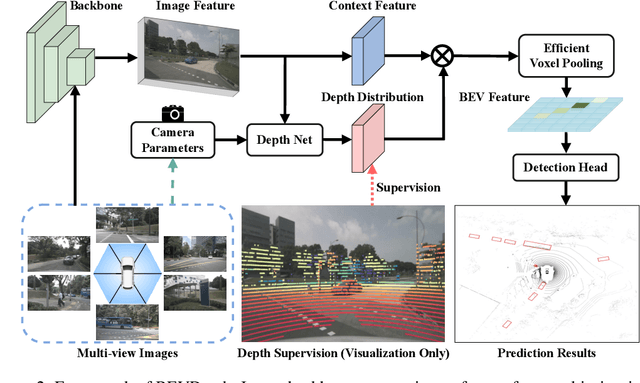Yukang Shi
Structured Labeling Enables Faster Vision-Language Models for End-to-End Autonomous Driving
Jun 05, 2025Abstract:Vision-Language Models (VLMs) offer a promising approach to end-to-end autonomous driving due to their human-like reasoning capabilities. However, troublesome gaps remains between current VLMs and real-world autonomous driving applications. One major limitation is that existing datasets with loosely formatted language descriptions are not machine-friendly and may introduce redundancy. Additionally, high computational cost and massive scale of VLMs hinder the inference speed and real-world deployment. To bridge the gap, this paper introduces a structured and concise benchmark dataset, NuScenes-S, which is derived from the NuScenes dataset and contains machine-friendly structured representations. Moreover, we present FastDrive, a compact VLM baseline with 0.9B parameters. In contrast to existing VLMs with over 7B parameters and unstructured language processing(e.g., LLaVA-1.5), FastDrive understands structured and concise descriptions and generates machine-friendly driving decisions with high efficiency. Extensive experiments show that FastDrive achieves competitive performance on structured dataset, with approximately 20% accuracy improvement on decision-making tasks, while surpassing massive parameter baseline in inference speed with over 10x speedup. Additionally, ablation studies further focus on the impact of scene annotations (e.g., weather, time of day) on decision-making tasks, demonstrating their importance on decision-making tasks in autonomous driving.
Structured Knowledge Distillation Towards Efficient and Compact Multi-View 3D Detection
Nov 21, 2022Abstract:Detecting 3D objects from multi-view images is a fundamental problem in 3D computer vision. Recently, significant breakthrough has been made in multi-view 3D detection tasks. However, the unprecedented detection performance of these vision BEV (bird's-eye-view) detection models is accompanied with enormous parameters and computation, which make them unaffordable on edge devices. To address this problem, in this paper, we propose a structured knowledge distillation framework, aiming to improve the efficiency of modern vision-only BEV detection models. The proposed framework mainly includes: (a) spatial-temporal distillation which distills teacher knowledge of information fusion from different timestamps and views, (b) BEV response distillation which distills teacher response to different pillars, and (c) weight-inheriting which solves the problem of inconsistent inputs between students and teacher in modern transformer architectures. Experimental results show that our method leads to an average improvement of 2.16 mAP and 2.27 NDS on the nuScenes benchmark, outperforming multiple baselines by a large margin.
BEVDepth: Acquisition of Reliable Depth for Multi-view 3D Object Detection
Jun 21, 2022



Abstract:In this research, we propose a new 3D object detector with a trustworthy depth estimation, dubbed BEVDepth, for camera-based Bird's-Eye-View (BEV) 3D object detection. By a thorough analysis of recent approaches, we discover that the depth estimation is implicitly learned without camera information, making it the de-facto fake-depth for creating the following pseudo point cloud. BEVDepth gets explicit depth supervision utilizing encoded intrinsic and extrinsic parameters. A depth correction sub-network is further introduced to counteract projecting-induced disturbances in depth ground truth. To reduce the speed bottleneck while projecting features from image-view into BEV using estimated depth, a quick view-transform operation is also proposed. Besides, our BEVDepth can be easily extended with input from multi-frame. Without any bells and whistles, BEVDepth achieves the new state-of-the-art 60.0% NDS on the challenging nuScenes test set while maintaining high efficiency. For the first time, the performance gap between the camera and LiDAR is largely reduced within 10% NDS.
 Add to Chrome
Add to Chrome Add to Firefox
Add to Firefox Add to Edge
Add to Edge